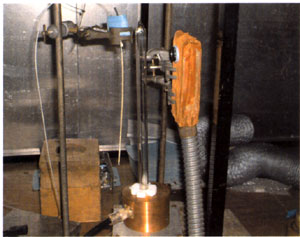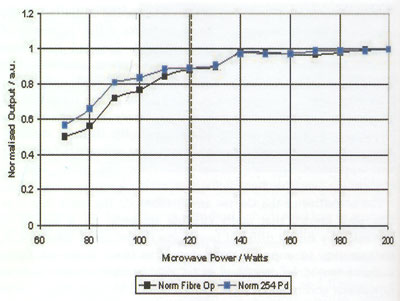| 2003 |

|
YEAR BOOK |
University of Limerick
|
Making light work of decontaminating water supplies
|

Why be concerned about our water supply?
Waterborne viruses and bacteria in drinking water supplies are a serious problem in Ireland and constitute a genuine threat to the nation's public health and wellbeing. The Environmental Protection Agency (EPA), in a recently well-publicised report on the quality of drinking water in Ireland, stated that water supplies should be 'free from any micro-organisms and parasites and from any substance which, in numbers or concentrations, constitute a potential danger to public health'. In addition to the well-publicised E-Coli bacteria, there are several other equally poisonous micro-organisms potentially present in our drinking water - such as cryptospyridium, which accounts for 5% of diarrhoea in children in Ireland.
Why use Ultra Violet light?
Sterilisation of water supplies using Ultra Violet (UV) light is a technique which is rapidly growing and gaining favour over chemical techniques. The advantages of using UV light are many-fold, and include neither colouring, creation of foul taste nor smell on the water and rapid killing of bacteria and viruses, e.g. cryptospyridium. UV may be further used to generate ozone, which is also an effective germicidal substance. Disadvantages have included relatively high cost of lamps and poor output power of lamps.
What are we doing about it?
The Optical Fibre Sensors Research Group at the University of Limerick has been involved in a collaborative research project with the Industrial Microwave Research Group at the University of Liverpool, UK, in developing and monitoring a high power Microwave powered UV Lamp (MPUVL). It is necessary to monitor the Lamp (initially developed by the team at Liverpool) so that it may be controlled and the UV dose delivered to the water supply measured. It is important to control the lamp so that it operates in the manner which delivers the right wavelength to ensure maximum germicidal effectiveness.
Where do optical fibres come into this?
The lamp can be monitored by conventional UV light detectors (semiconductors). However, these devices suffer due to ageing on continuous exposure to the high intensity UV light, but also are subject to interference by the microwave power source of the lamp. Optical fibres are immune to such interference effects as they are designed only to guide light, and external microwave electric fields do not interfere with this. The fibres used by the UL group are not designed to transmit UV and therefore have had to be specially coated with a material which converts the UV into visible light which the fibre can transmit. The sensor which the team at UL has created is therefore robust and immune to the effects of the MPUVL light source. As the sensor is encapsulated in a protective coating, it can be safely used in water systems since it uses only optical signals and does not contaminate those systems in any way.
How do we know the sensor is doing its job?
Several measurements have already been conducted at the research labs at the University of Liverpool using the optical fibre sensor and the MPUVL. To date the output power of the lamp has been measured over a period of use of several weeks where the lamp has been operated in continuous and pulse (on off) modes. In order to measure the optical fibre sensor's performance against the conventional UV detector, it was necessary to run the two side by side. This was not easy, as the conventional sensor needed considerable shielding from the microwave field as well as the use of an expensive optical filter in front. However this test showed that the optical fibre sensor faithfully measured the output power of the UV light source over a wide range input power. This result is shown in Figure 2.

Contact: Dr Elfed Lewis, E-mail: [email protected] ;
Dr Colin Fitzpatrick,E-mail: [email protected] ;
Mary McSherry,E-mail: [email protected]